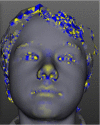3-Dimensional Facial Analysis-Facing Precision Public Health
- PMID: 28443272
- PMCID: PMC5385440
- DOI: 10.3389/fpubh.2017.00031
3-Dimensional Facial Analysis-Facing Precision Public Health
Abstract
Precision public health is a new field driven by technological advances that enable more precise descriptions and analyses of individuals and population groups, with a view to improving the overall health of populations. This promises to lead to more precise clinical and public health practices, across the continuum of prevention, screening, diagnosis, and treatment. A phenotype is the set of observable characteristics of an individual resulting from the interaction of a genotype with the environment. Precision (deep) phenotyping applies innovative technologies to exhaustively and more precisely examine the discrete components of a phenotype and goes beyond the information usually included in medical charts. This form of phenotyping is a critical component of more precise diagnostic capability and 3-dimensional facial analysis (3DFA) is a key technological enabler in this domain. In this paper, we examine the potential of 3DFA as a public health tool, by viewing it against the 10 essential public health services of the "public health wheel," developed by the US Centers for Disease Control. This provides an illustrative framework to gage current and emergent applications of genomic technologies for implementing precision public health.
Keywords: 3D facial scan; developmental disabilities; genomics and genetics; public health; rare diseases; spatial information.
Figures


References
-
- Office of Population Health Genomics. WA Rare Diseases Strategic Framework 2015-2018. Perth, Australia: Public Health Division, Department of Health Western Australia; (2015).
-
- European Organisation for Rare Diseases. Rare Diseases: Understanding this Public Health Priority. Paris, France: EURORDIS; (2005).
-
- Aymé S, Rodwell C. Report on the State of the Art of Rare Disease Activities in Europe. Paris: European Union Committee of Experts on Rare Disease, European Union; (2013).
LinkOut - more resources
Full Text Sources
Other Literature Sources

